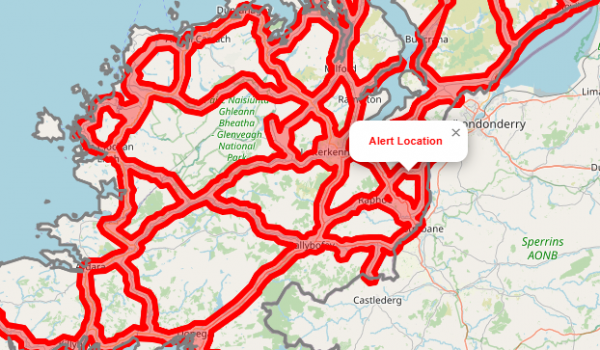
Donegal County Council officials have stressed that the authority has no jurisdiction or role in relation to private rights of way.
There was a lengthy discussion at this month’s Letterkenny Municipal District meeting on foot of two motions from Cllr Ian McGarvey.
Cllr Mc Garvey proposed two linked motions, one of them proposing that all rights of way are kept open, and the other that the Municipal District create a replacement road at Aughadahor in Carrigart.
The council’s Planning Director Liam Ward told members that in cases where the existence of a right of way on private land is not accepted by the owners, and a case is being made on the basis of long term use, the law on that is quite complex.
He cited a recent case at Lisaddell in Sligo, which left Sligo County Council facing considerable costs.
On the call for a replacement road at Aughahdor, Mr Ward said while there is a process within legislation to provide for the creation of a public Right of Way, he would not recommend such a course of action in light of the the legal complexities that exist, and the potential financial exposure for the Council.
Cllr McGarvey expressed disappointment at the recommendation, suggesting that not acting on this issue would be a subversion of democracy.
Mr Ward accepting that there are issues, but stressed the suggested course of action was not the way to resolve them.
*****************************
Cllr. Ian McGarvey
19) That this M.D. ensure that all rights of way are kept open.
Answer: It should be noted that a very similar motion was considered at a plenary Meeting of Donegal Co. Council in September 2019. The response below was provided and remains the position. On consideration, the Council resolved not to adopt this motion at the September 2019 meeting and it is recommended that MD members adopt the same position.
The motion refers to all rights of way but as the Council has no jurisdiction or role in relation to private rights of way, the motion proposed is taken to be referring to public rights of way only and it is advised that when being considered by members, it should be amended accordingly and taken to read as Public Rights of Way only.
Subject to the above clarification, I wish to advise as follows;
1. All public roads have public rights of way over them and are already listed on the roads schedule as roads in the charge of the Council.
2. Turning then to roads, accesses etc. that are not public roads, same fall into a number of categories highlighted below including –
(a) Roads that the Council decide should be declared to be public roads in accordance with Section 11 of the Roads Act 1993. If such a declaration is made they then become listed on the roads schedule in the same way as all other existing public roads. Any declaration is subject to a number of requirements including –
• That the road is of general public utility.
• That the Council must first consider the financial implications of any proposed declaration.
• That the public consultation procedure as set out in the legislation is followed with any objections/representations made by way of reply to the published notice are considered by the Council before any decision is made.
(b) Public rights of way created in accordance with Sections 206 (agreement) or 207 (compulsory procedure) of the Planning and Development Act 2000 – In accordance with Section 208 such rights of way have to be maintained by the Council and anyone damaging or obstructing the way or hindering or interfering with the exercise of the right of way is committing an offence for which they can be prosecuted. In the case of such damage or obstruction the Council can also repair any damage and remove any obstruction and seek the costs involved against the person responsible.
(c) The position per sub-paragraph (b) immediately above also applies to public rights of way where there is a provision in a Development Plan relating to their preservation. Currently there are 44 public rights of way listed in this way in the County Development Plan 2018 – 2024 Table 15, Appendix 3, pages 264/265. It is accepted that in certain instances relating to listed public rights of way, it is difficult for the Council to be definitive in relation to which pathway is being preserved. In such instances, it will be necessary under the next review of the County Development Plan to clarify such cases.
(d) The remaining public rights of way within the County are those that are not protected either as public roads or in accordance with Section 208 of the Planning and Development Act 2000 as above. Any proposal to add further existing public rights of way to those preserved/protected in the Development Plan would have to be considered as part of the procedure for varying the same or when a new plan is made.
3. The following should be noted in respect of any proposals per 2(d) immediately above –
(a) The legislation does not envisage that all public rights of way should be listed/protected in the manner detailed above. Such ways that have protected/preserved status have all to be maintained by the Council and the costs of doing that would have to be considered. It is suggested therefore that any case being made for including a particular existing public right of way into the protected/preserved category should be justified on the merits of the way in question rather than looking at all such public rights of way generally.
(b) It is important that there be no issue about the existence of a public right of way over the road/access in question. If the legal owners of the way are acknowledging the existence of a public right of way or there is evidence of a dedication of same as a public right of way by a previous owner(s), that would usually suffice. However where the position is not accepted by the owners and a case is being made that long use by members of the public should be taken as evidence of presumed dedication by an
owner in the past, the law on that is quite complex. Members will be aware of the Lisaddell case in Sligo a number of years ago where the owners of the property successfully challenged up to the Supreme Court the inclusion by Sligo County Council of an objective to preserve certain public rights of way inserted in the plan.
4. In summary, it is therefore recommended that this motion should not passed by the members and as outlined above, any such proposals to be put forward and considered as per paragraph 2(d) above.
20) That this M.D. create a replacement for the road allowed be de-commissioned at Aughadahor, Carrigart
Answer: It is noted that the same issues arise with respect to this motion as exists with the previous Motion in relation to Rights of Way.
The same reply from the Council is relevant in this regard. As outlined, there is a process within legislation to provide for the creation of a public Right of Way. However, given the legal complexities that exist and the significant financial exposure for the Council which may arise, it is recommended that the Council not proceed with this course of action.
- Fri, 26 Dec 2025
- (+353) 07491 25000
- (+353) 086 60 25000





